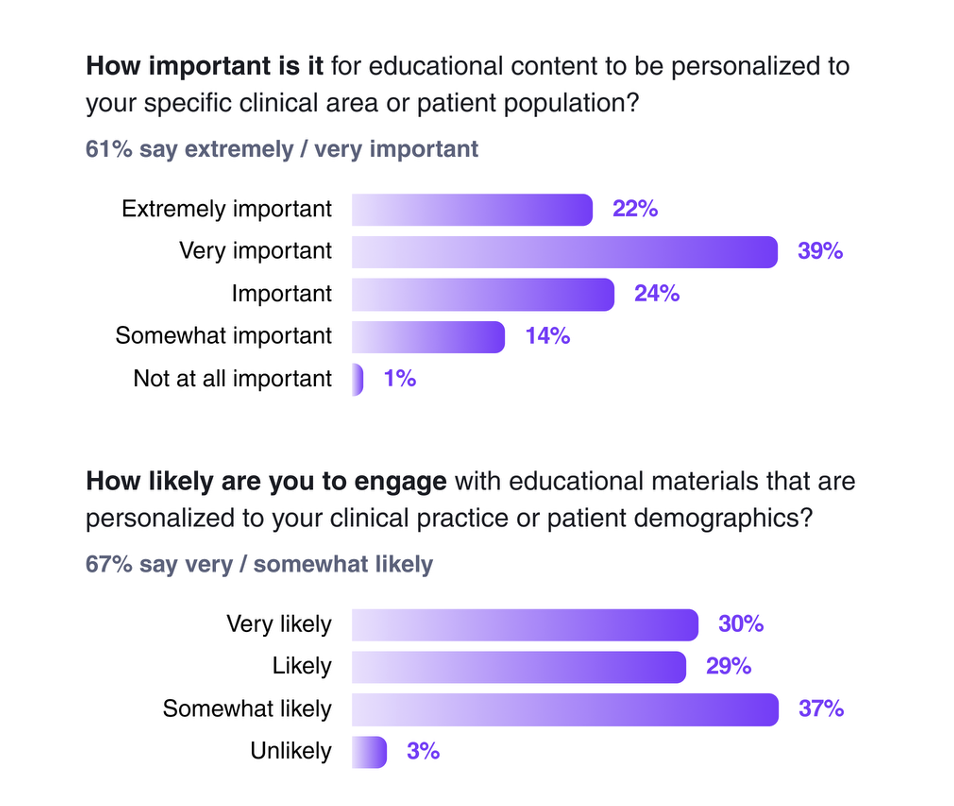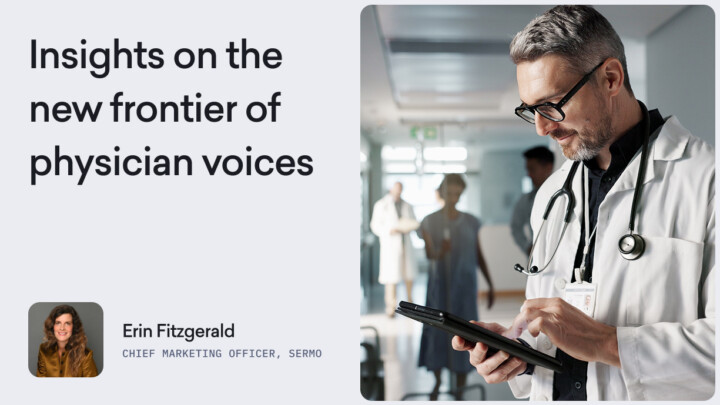
Physician engagement has never been more competitive or more critical. Between packed clinic schedules, information overload, and endless digital distractions, breaking through to busy HCPs requires more than clever campaigns. It requires relevance, timing, and a strategy built on data about what actually works.
Drawing on Sermo’s 2025 Program Impact Benchmarks, RealTime KOLs Study, and fresh HCP sentiment data, here are eight proven ways to reach physicians, inspire action, and keep them coming back.
Tip #1: keep it short
Physicians are busy. They don’t want to wade through a wall of words to get to the point — and they won’t. According to Sermo’s 2025 Program Impact Benchmarks,
- 63% of HCPs say they want short-form, bite-sized content that delivers fast facts
- 57% say they prefer short videos (under 5 minutes)
And here’s the kicker: short video doesn’t just get watched, it drives action. Programs using video on Sermo show a 45% increase in intent to discuss with a peer and a 60% increase in intent to prescribe.

Do this: deliver your message in concise formats — quick reads, snackable infographics, and short videos that can be consumed between patient visits.
Not that: bury the message in long, dense copy that physicians don’t have time to read.
Tip #2: partner with opinion leaders
Physicians trust the voices of their peers. The RealTime KOLs Study (August 2024, N=1,010) found that:
- 53% of physicians say KOLs have inspired them to conduct additional treatment research
- 72% are more likely to consider product information when it comes from a trusted KOL
- 75% have shared KOL content with a colleague or friend

When information comes from respected clinical voices, it doesn’t just get noticed, it sparks action.
Do this: collaborate with credible Key Opinion Leaders (KOLs) who are respected in their fields and can translate evidence into practical insights.
Not that: partner with generic “influencers” who may have reach but lack clinical credibility.
Tip #3: get social
Not all social media platforms are created equal and physicians use them differently depending on the context. The Sermo RealTime Navigating Professional Social Media Survey (August 2025) found that:
- 62% of HCPs use Sermo for professional purposes, followed by Doximity (44%) and LinkedIn (35%)
- When using HCP-only platforms, 61% of physicians say they are “much more medically/professionally focused” than on public social media
This means your strategy shouldn’t lump all social channels together. Physicians treat professional platforms as a space for serious, clinical discussion — not casual scrolling.
Do this: meet physicians where they are professionally — on Sermo, Doximity, and other trusted HCP networks — and deliver content that respects the professional context.
Not that: assume that posting the same message across Instagram, Facebook, and LinkedIn will have the same impact.
Tip #4: bring the congress to physicians’ devices
Most physicians aren’t attending every major medical congress — far from it. According to Sermo HCP Sentiment Part 16 (n=499):
- The average number of congresses attended per physician is 2.5 per year
- Nearly half (48%) attended only 1–2 congresses in the last year
- 10% didn’t attend any

This means that critical clinical updates are often missed unless they’re delivered in another format.
Do this: capture the key insights from major congresses and deliver them digitally. Consider short summaries, videos, and expert takeaways that can be accessed on demand.
Not that: assume your audience was sitting in the front row for the data presentation. Most weren’t and they still need to know what it means for their practice.
Tip #5: deliver value beyond the logo
Physicians want more than brand promotion — they want resources that help them deliver better care. Leading teams build engagement by supporting physicians across the entire product journey. For example, one Sermo partner:
- Pre-launch: provides disease state education to help HCPs better understand patient populations and unmet needs
- Year of launch: paired disease state videos with KOL-led outreach for maximum impact
- Year after launch: shared mechanism-of-action content to deepen clinical understanding

Do this: deliver value at every stage, from unbranded disease state education to practical resources that make physicians’ jobs easier.
Not that: focus solely on brand awareness or top-of-funnel impressions.
Tip #6: make physicians feel like your content was made for them
Personalization isn’t a nice-to-have, it’s what drives engagement. According to Sermo HCP Sentiment Part 16 (n=499):
- 61% of physicians say it is “extremely” or “very important” for educational content to be personalized to their clinical area or patient population
- 59% say they are “very” or “somewhat likely” to engage with content that is personalized in this way

The takeaway is simple: when content feels relevant to a physician’s practice, they are far more likely to spend time with it and act on it.
Do this: use specialty-specific insights, relevant patient demographics, and localized data to tailor your content so it feels designed for the audience you’re targeting.
Not that: push out generic, one-size-fits-all content that fails to speak to their day-to-day challenges.
Tip #7: show real-world cases
Physicians don’t want perfect hypotheticals; they want content that reflects the complexity of real practice. The most engaging programs show what clinical decision-making really looks like, including the gray areas and tough calls.

Do this: present authentic, nuanced cases that spark discussion and let physicians see how peers approach challenging scenarios.
Not that: stick to overly simple, picture-perfect cases that don’t reflect the realities of patient care.
Tip #8: speak their language
Physicians pay attention when information is relevant, clear, and clinically grounded. The data shows they’re drawn to terms that signal real-world impact — such as “now approved,” “newest guidelines,” “real-world evidence,” and “safety data.”
But language matters. Overly corporate or jargon-heavy messaging can turn them off.
Do this: use the language physicians use, focused on patient care, evidence, and outcomes, and make it easy for them to see why it matters.
Not that: bury your message in marketing speak or buzzwords that dilute the clinical relevance.
The bottom line
Engaging physicians isn’t about doing more, it’s about doing better. These eight strategies show that relevance, trust, personalization, and clarity aren’t optional, they’re what separates the programs physicians ignore from the ones they act on. When brands deliver content that is concise, credible, and clinically meaningful, they don’t just capture attention, they influence behavior and improve outcomes.
On behalf of Sermo, thank you for checking out our blog post on physician engagement best practices. This is just one of the many examples of how we can inform digital strategies from our global panel of HCPs and healthcare experts.
At Sermo, we turn physician experience, expertise, and observations into actionable insights for the global healthcare community. Engaging with more than 1 million HCPs across 150 countries, we provide physicians with a social platform that fosters impactful peer-to-peer collaboration & discussions about issues that are important to them and their patients. Sermo offers on-demand access to physicians via a suite of proprietary technology to provide business intelligence that benefits pharmaceutical, healthcare partners and the medical community at large.
Interested in learning more? Please visit us at sermo.com/business and follow us on Facebook, Twitter and LinkedIn for the latest and greatest in healthcare insights.














